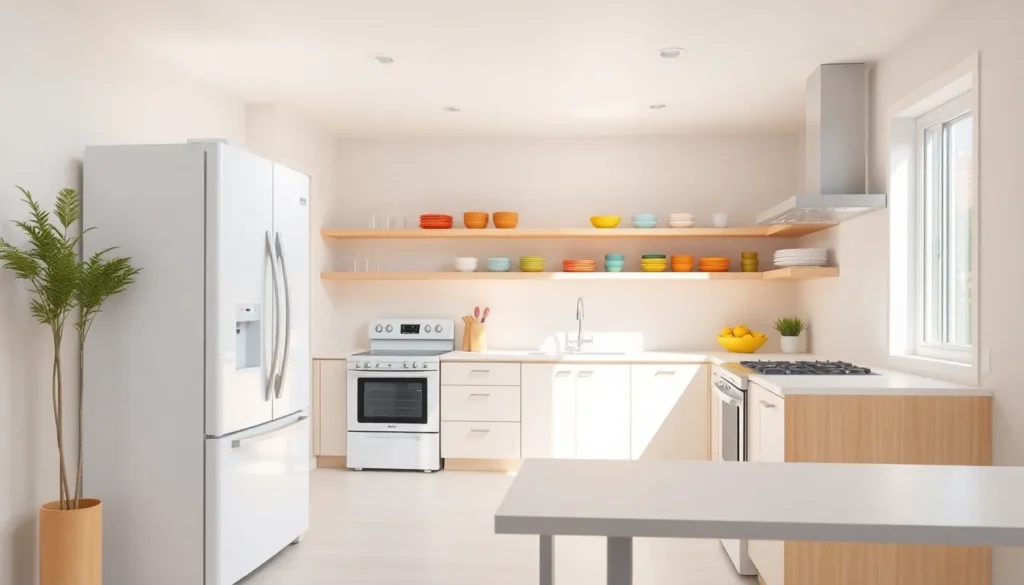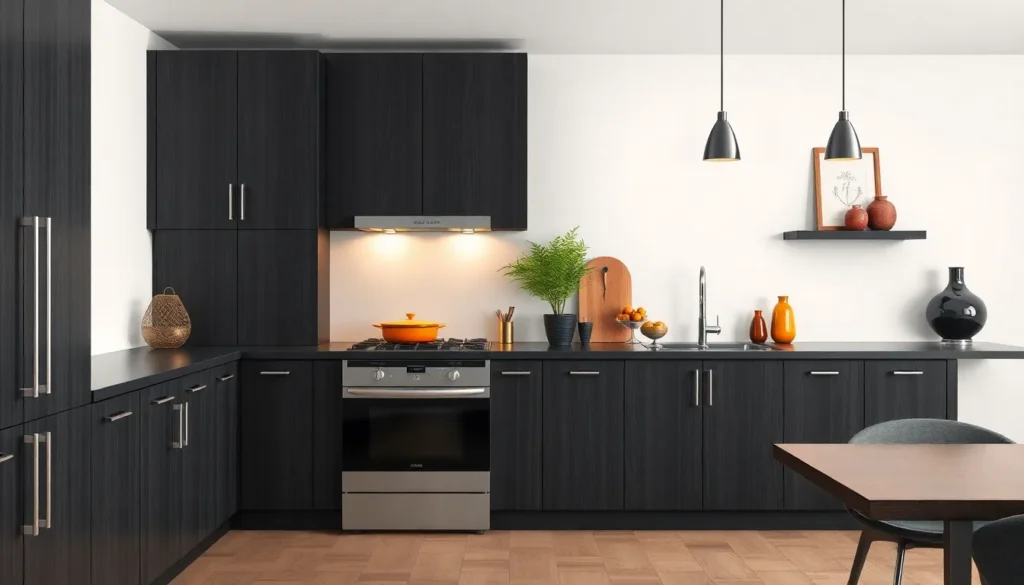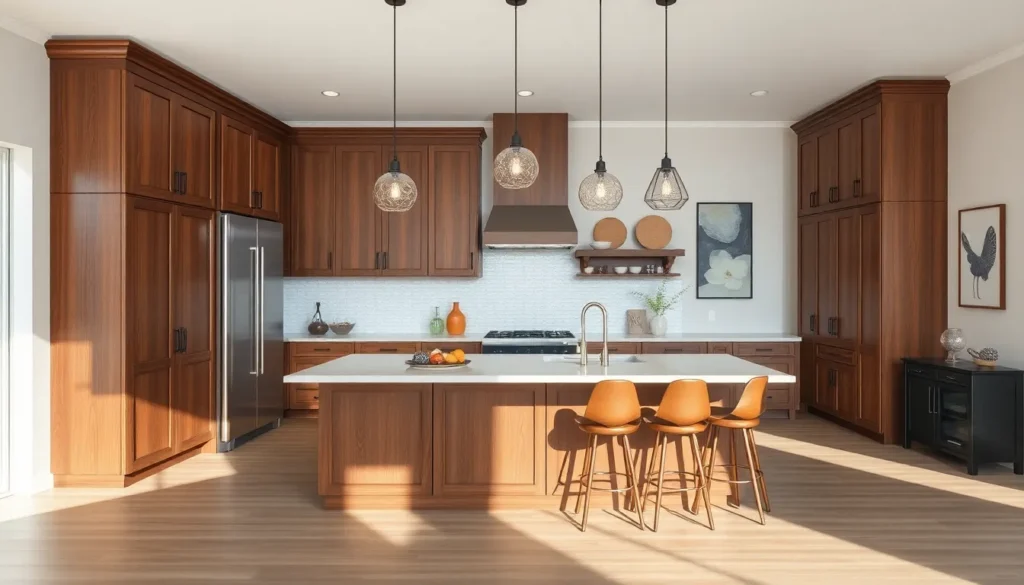Imagine whipping up a gourmet meal in a kitchen that’s as unique as your culinary creations. DIY kitchens offer the perfect blend of creativity and practicality, allowing anyone to transform their cooking space without breaking the bank. Whether it’s a fresh coat of paint or a complete overhaul, the possibilities are endless—and so is the potential for minor mishaps that could lead to hilarious kitchen stories.
Table of Contents
ToggleUnderstanding DIY Kitchens
DIY kitchens enable individuals to creatively enhance their cooking spaces while maintaining a sense of personal touch. Such projects often range from simple modifications to complete renovations, making them a popular choice among homeowners.
What Are DIY Kitchens?
DIY kitchens refer to kitchen renovations executed by homeowners without reliance on professional contractors. These projects can involve painting cabinets, installing new countertops, or even building custom shelves. Homeowners often select materials and design elements that reflect their style and functionality preferences. Emphasis on hands-on work allows individuals to take ownership of their kitchen space, resulting in a unique and personalized environment.
Benefits of DIY Kitchens
DIY kitchens offer various advantages. Cost savings stand out as one of the primary benefits since homeowners avoid labor costs associated with hiring professionals. Flexibility also plays a significant role; individuals can design and execute renovations on their own schedules. Creative expression fosters a strong connection to the space; unique projects yield a sense of pride. Acquiring new skills is another important aspect, as homeowners learn practical techniques along the way. Overall, DIY kitchens create opportunities to create functional and aesthetically pleasing environments.
Planning Your DIY Kitchen
Planning a DIY kitchen involves careful consideration of various elements. Homeowners can take specific steps to ensure a successful renovation.
Setting a Budget
Establishing a budget remains crucial in any DIY project. Calculate costs for materials such as cabinets, countertops, and appliances to avoid overspending. Track prices from multiple suppliers to secure the best deals. Allocate extra funds for unexpected expenses, typically ranging from 10% to 20% of the total budget. Prioritize essential items, ensuring functionality remains a top focus. Consider financing options if needed, especially for larger renovations to maintain cash flow.
Designing Your Space
Designing the kitchen space involves strategic planning. Choose a layout that promotes efficiency, such as the work triangle concept, which optimizes the distance between the sink, stove, and refrigerator. Select a color scheme that reflects personal style and complements the overall theme. Incorporate storage solutions like floating shelves or under-cabinet organizers to maximize space. Create a mood board to visualize design elements, making it easier to coordinate styles. Ensure adequate lighting, blending natural and artificial sources for a welcoming atmosphere.
Materials and Tools Needed
Creating a DIY kitchen requires a selection of essential tools and materials that facilitate the renovation process. Understanding these components helps ensure a successful project.
Essential Tools for DIY Kitchens
Power drills simplify the process of installing cabinets and fixtures. Screwdrivers accommodate various fasteners and components. Measuring tapes allow accurate measurements for countertops and shelves. Leveling tools ensure everything is aligned, which promotes a polished appearance. Paintbrushes and rollers facilitate the application of different finishes on surfaces, adding a personal touch. Safety gear is crucial; goggles protect the eyes while masks filter dust and fumes.
Recommended Materials
Plywood forms the foundation for cabinets and shelving units due to its durability and versatility. Laminate countertops provide an affordable option with a variety of finishes. Paint helps refresh cabinets and walls, offering numerous color possibilities. Hardware such as handles and hinges enhances functionality and style. Backsplashes using tiles or panels contribute to the kitchen’s overall aesthetic. Lighting fixtures improve visibility, highlighting design elements and creating ambiance.
Step-By-Step DIY Kitchen Projects
DIY kitchen projects can enhance both functionality and aesthetics. Each project allows homeowners to put their personal touch on their spaces.
Renovating Cabinets
Renovating cabinets provides an excellent opportunity for transformation. Homeowners can remove old doors and paint or stain them for a fresh look. Adding new hardware improves functionality and style significantly. High-quality paint or laminate can rejuvenate surfaces effectively. Self-closing hinges or soft-close drawers enhance usability. Consider replacing cardboard or particle board with solid wood for better durability. Detailed planning ensures homeowners allocate enough time and resources to complete the project.
Installing Countertops
Installing countertops involves selecting materials that suit both visual appeal and practicality. Homeowners often choose durable materials such as granite, quartz, or laminate for longevity. Accurate measurements are crucial before cutting the countertop. Fastening brackets beneath the countertop provides additional support. Proper sealing of seams prevents moisture damage, extending lifespan. Calibrating installation levels ensures a seamless fit against backsplash and cabinets. The right tools, such as a circular saw and clamps, facilitate smooth installation.
Backsplash Installation
Backsplash installation adds a decorative and functional element to kitchens. Homeowners frequently use tiles, glass, or metal for distinctive designs. Preparation includes cleaning the wall surface and planning layout beforehand. Ensuring correct spacing with tile spacers results in professional-looking alignment. Adhesive application requires precision for secure attachment. Grouting follows to fill gaps, creating a polished finish. Sealing grout helps protect against stains and moisture, enhancing longevity. Planning ensures compatibility with countertops and cabinetry, fostering an integrated appearance.
Tips for a Successful DIY Kitchen
Planning a successful DIY kitchen requires attention to detail and awareness of potential pitfalls. Knowing what to avoid can significantly improve outcomes.
Common Mistakes to Avoid
Homeowners often underestimate the importance of proper measurements. Accurate measurements prevent costly mistakes during material selection and installation. Neglecting to set a realistic budget results in overspending, so ensuring expenses align with financial constraints is crucial. Skipping thorough research on materials can lead to choosing low-quality products that compromise durability. Ignoring safety protocols might cause injuries during installation, emphasizing the need for appropriate safety gear. Moreover, failing to seek assistance when needed can prolong projects or lead to frustration, reinforcing the value of asking for help from friends or family.
Resources for Inspiration
Utilizing online platforms provides a wealth of inspiration for DIY kitchens. Websites such as Pinterest and Houzz showcase countless design ideas, catering to different styles and preferences. Visiting local home improvement stores often uncovers trending materials and fixtures to incorporate into plans. Attending workshops or webinars offers access to expert advice and hands-on experience, enhancing skill sets. Exploring home décor magazines can reveal innovative kitchen designs, combining aesthetics with functionality. Watching DIY video tutorials on platforms like YouTube provides step-by-step guidance, simplifying the learning process and encouraging creativity.
DIY kitchens offer an exciting opportunity for homeowners to create unique and personalized cooking spaces. With a blend of creativity and practicality, individuals can transform their kitchens while enjoying the process. Embracing the DIY approach not only saves money but also allows for self-expression and skill development.
By planning carefully and utilizing the right tools and materials, anyone can tackle projects ranging from cabinet renovations to backsplash installations. The journey may come with its challenges but the rewards of a customized kitchen make it worthwhile. With inspiration readily available and a little determination, achieving a stunning DIY kitchen is within reach for anyone willing to take on the challenge.









